Report: The Lion dance (Shishimai) in Sawai, urban Tokyo
It is impossible to talk about folk performing arts in Japan without discussing “Shishimai”. Although Shishi means lion, this is not a real lion. The original source is said to have come from India, so it is said that a real lion had been an object of worship there. However, as it spread throughout the West, China, Korea and Nepal, it became an imaginary spiritual animal. Some say that Chinese emperors had lions, so it’s possible that they knew about the real lion up to that point.
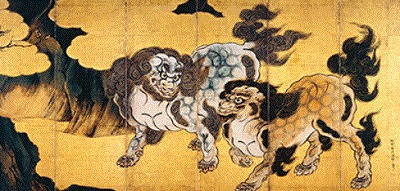
収蔵作品詳細/唐獅子図屏風 – 宮内庁 (kunaicho.go.jp)
Date: Sunday closest to July 25 (Most often the fourth Sunday of the month)
Place: Yagumo shrine, 2-902 Sawai, Okutama town, Tokyo
Access: A few minutes walk from Sawai Station on the JR Oume Line. It takes about one and a half hours to get to Sawai from either Tokyo or Shinjuku.
Shishimai (lion dance)’s history
It is said to have been introduced to Japan around the 6th century, at the same time as Buddhism. In 752, when the Great Buddha was built at Todaiji (東大寺) Temple as a national project, the lion dance was performed. It is said that half of the population of the time was involved in the construction of the Great Buddha, and about 10,000 people gathered for the unveiling of the statue. It is said that this is how the lion dance spread across the country.
However, there are various routes as to how it had been introduced to Japan, and thus a variety of lion dances have been born. It is said that there are now about 8,000 of them active.
Shishimai can be divided into two main groups: Ise-Daikagura (伊勢太神楽) style and Furyu (風流) style. The Ise-style dance is performed by two people, while the Furyu-style dance is performed by one person holding a small drum called Kakko. However, it is so diverse that there is naturally a mix of these as well. The Ise-Daikagura-style is distributed in western Japan, while the Furyu-style is mostly distributed in eastern Japan.
Introduction of the Lion dance of Sawai
This time, this site is going to introduce Shishimai in Tokyo. The main style in Kanto region (including Tokyo) is three units of “one-man shishi dancers” comprising one group.
Nevertheless, there is a variety of lion dances in Kanto, and even in Tokyo there is diversity. This time, I would like to take a look at one from the Okutama area first. The Okutama area may be the closest vacation spot for those living in Tokyo. It has ravines, waterfalls, mountains, and scenic beauty. It can be reached from the center of Tokyo in about an hour by train. An area that many people visit in summer to cool off. There are groups that practice canoeing on the river, and many groups enjoy hiking and camping. It is precisely because of such an area that the cohesion of the community is rather strong and there are many performing arts that have been passed down.


As we pass Ome (青梅), we start to see mountains around us, and the atmosphere starts to change. As most of the passengers are backpackers, the Okutama (奥多摩) area is just around the corner. There are reasonable hiking trails, mountain climbing trails, and ravines around the area, and the passengers get off at their desired destinations. When you get off the train, you find yourself in a quiet village surrounded by summer mountains, where the bustle of the city has disappeared. In the middle of the village, there is a small shrine. It looks just like an ordinary house. You would feel as if you are visiting a neighbor’s farmhouse. It’s Sawai Yagumo (沢井八雲) Shrine. This is the stage for today’s lion dance. As you walk up the stairs, you find a sandy stage about 10 meters square, surrounded by the shrine in front and audience seats on either side. The lion dance starts at 8:30 in the morning. But in the morning, the main activity is walking around the village. They walk around street by street performing their dance. This is not just to present themselves in public, but to celebrate the prosperity of the village and drive away the evil spirits.
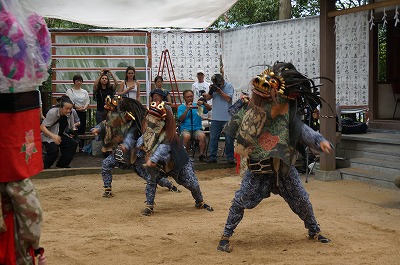
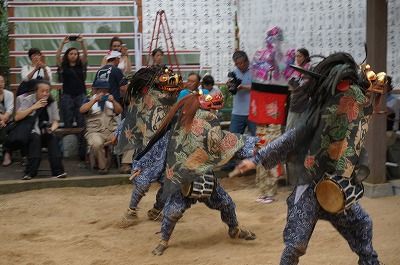
After lunch, they return to the shrine around 1:30 to perform a variety of acts. There are three lions. Two males and one female. The male lions are the elder and the younger. And four Hanagasa join them. This is the basic style. There are many theories as to why this style was adopted, but here in Sawai, it is said to represent the sun, moon, and stars. In Sawai, it is said to represent the sun, moon, and stars, and the four flower hats represent the four heavenly kings who protect the Buddha in Buddhism. The three lions are called ”Oh (elder)” lion, “Waka” (young) lion, and “Me (female)” lion.
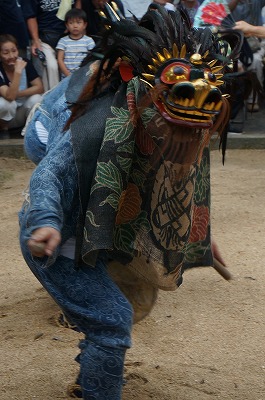
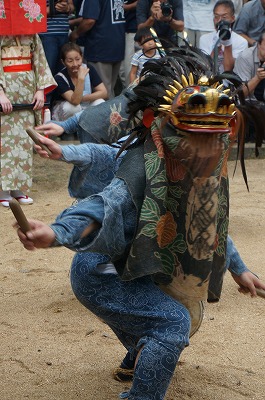
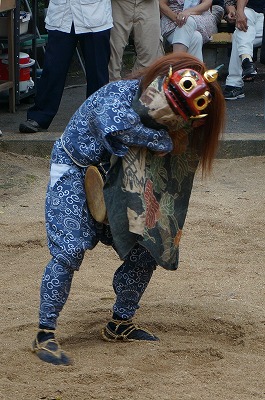
Hira-gurui 平狂い
The first performance is called “Hira-gurui”. In lion dance, a violent dance is often called “Kurui (mad dance)”. As the name suggests, this is also an intense dance. The age range of performers is wide, and this basic dance is usually performed by junior high to high school students. However, the ground below is soft sand. It’s like dancing on the beach, and we can imagine how exhausting it is.
It’s the height of summer. It’s hot. There is an electric fan running in front of the building, but it doesn’t help much for cooling. So, if there’s a pause in the middle or at the end of the dance, there are people who fan the dancers.
Kurenai-gakari 紅がかり
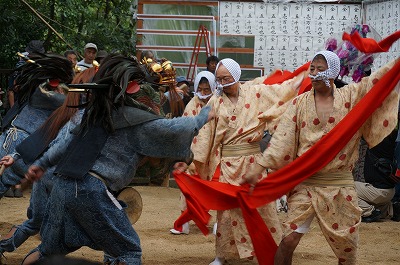
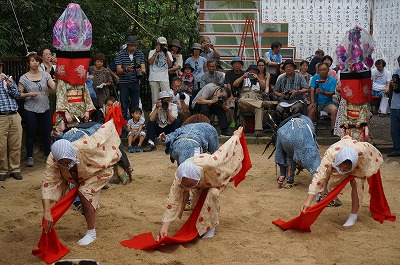
The next step is “Kurenai (deep red) gakari”. The lion dance often has a performance with this name. The word “kakari” seems to be used in the sense of relating to or showing interest in the subject. As the name implies, three rogues with deep red cloths come out and play with the lion. The lion’s interest in the red reminded me of a Spanish bullfight.
During the breaks, the famous local sake “Sawanoi” is served, and pickles are passed around. It was all very thoughtful. It doesn’t matter if you take it or not. In the plaza below the shrine, simple meals and beer are sold at a reasonable price, but if you want to eat well, it is best to bring your own food. There are no big stores or convenience stores nearby.
Tachi-gurui 太刀狂い

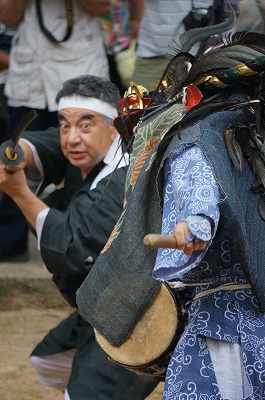
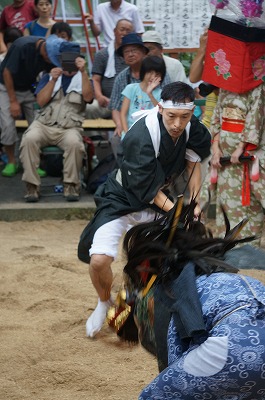
As the name suggests, a lion is entangled with a sword (Tachi means sword). Most of the swords are imitation, here they use imitation swords too. However, it was just barely enough to shave off 20%. They are almost serious about it. That’s why there is a sense of urgency in the air, as if a slight mistake could be made. It looks as if a lion and a man are engaged in a tense battle. As in any other performance, this one requires special training. The power of the lion dance can be seen in such a way.
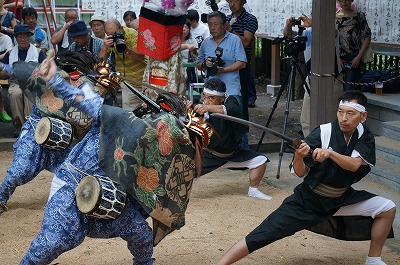
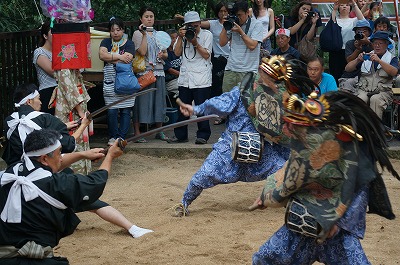
Sao-gakari 竿掛かり
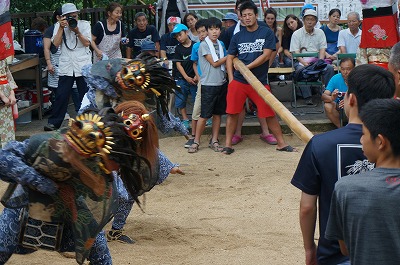

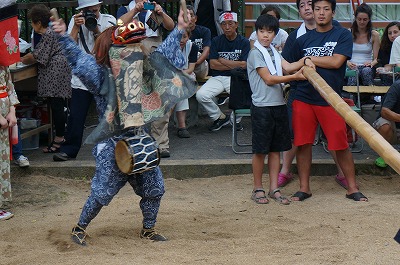
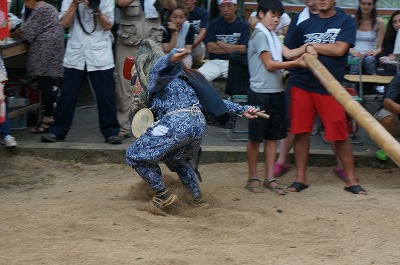
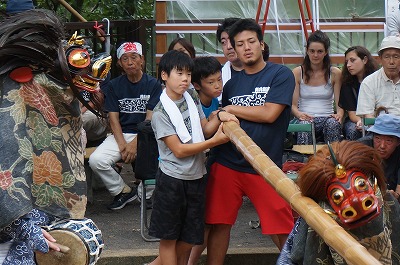
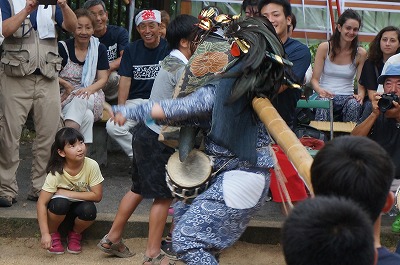

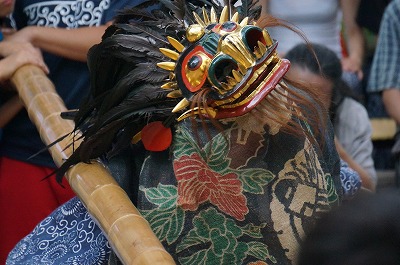
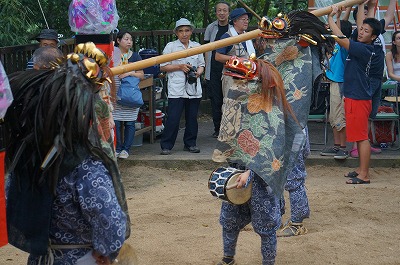

The lion dance sometimes has a representation of life. The same is true of this program. A pole (sao) is passed in the center. The lions are interested in the pole. But they are too scared to go over it. They try again and again, but each time they run back. They return with their hands behind their backs, as if they are expressing their fear with their whole body. And it is the female lion who is the first to cross the pole. The performance varies from each group of lion dance , but it is usually the female lion who is the first to cross the pole. And the elder lion is the one who hesitates until the end. It’s as if women are quicker to make decisions in life, and men who have too much stuff they don’t need are slower to adapt to change.
Mejishi-gura 雌獅子蔵
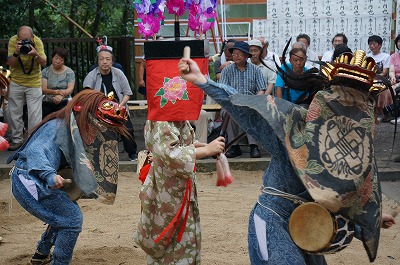
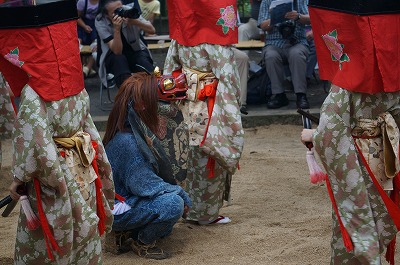
There is a performance in which a female lioness is hiding in every lion dance. I’m even wondering if that’s the reason why there are three lions two male lions and a female lioness. Simply put, it is a love triangle.

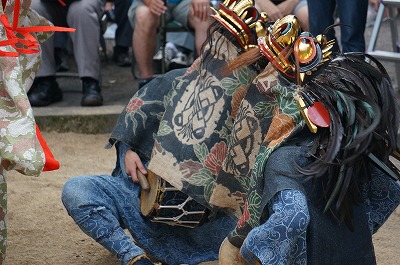
It starts out with the setting where the lions are on a journey. Eventually, the fog gets thicker and only the lionesses disappear. The two males panic and look around for her. They decide to split up and search for her. So far, there are no problems. After this, the young lion finds the female lioness first, but does not tell the elder lion. The elder lion is desperately searching for her. Eventually, he finds the two lions.
He says, “Oh, I didn’t know they were here…
Naturally, he was very angry. The young lion doesn’t even apologize, and a fierce battle ensues. This fight is one of the highlights of the story.
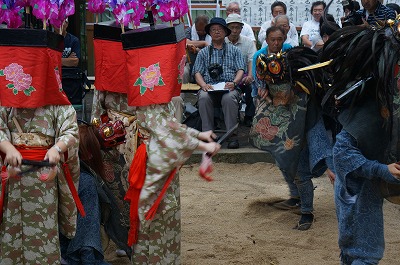
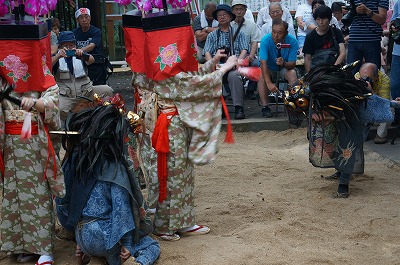
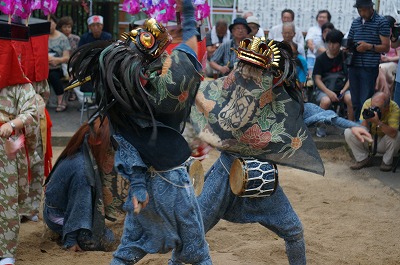
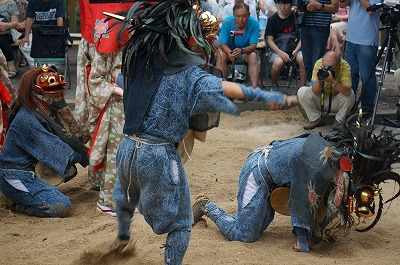
While they were fighting, the fog thickened again and the lioness disappeared. This is no time to fight. Once again, the two animals split up to look for her.
This time, the elder lion finds the lioness first. If you get hit, hit back. The same thing happens again.
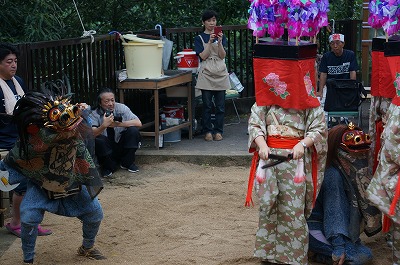

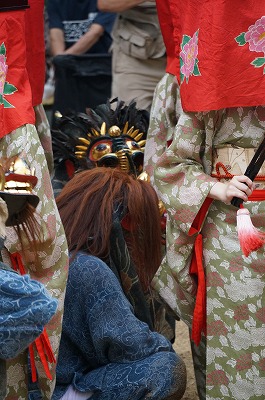
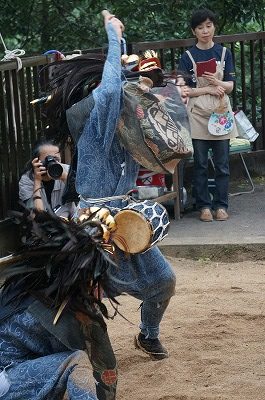
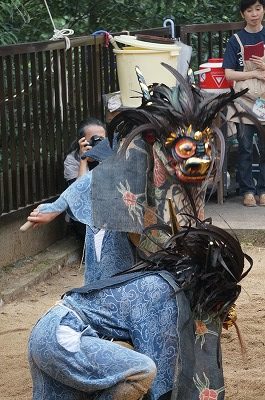
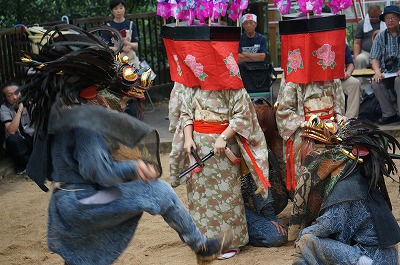
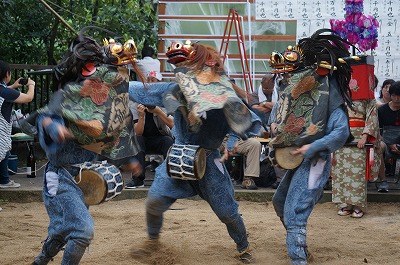
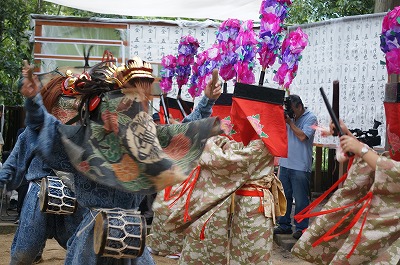
This fog thickening of fog is expressed by the densely packed Hanagasa hats on all sides. And finally the hanagasa return to their original positions, and the lions dance together as if nothing had happened.
I always wonder. Why did the old people create this kind of performance? Is it a warning or an irony? In any case, the person who created the original must have been quite a connoisseur.
Gokito 御祈祷

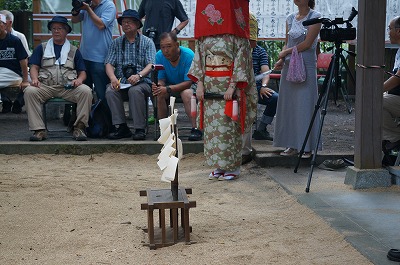
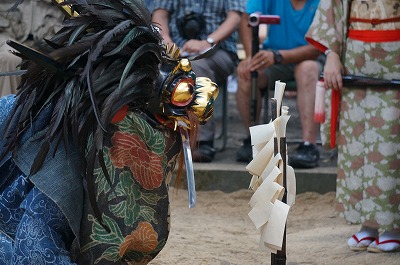
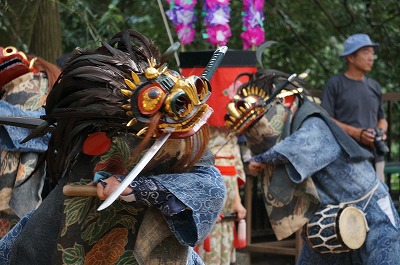
The final performance is called “purification. At the end of the day, evil spirits are driven away, the place is cleansed, and the dance is concluded.
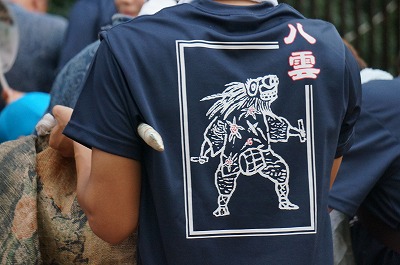

It ends at five in the evening. The Okutama area is a little cooler than the city center. The lion dance depicted on the back of stuff is dancing proudly. And so, one by one, summer comes to an end. You may look back at the road your came from, feeling as if the sound of lion dance drums and flutes are still echoing, but all you see is a quiet village that has regained its daily life. The fog in the mountains seemed to have lifted. The day is long. Let’s go home slowly.